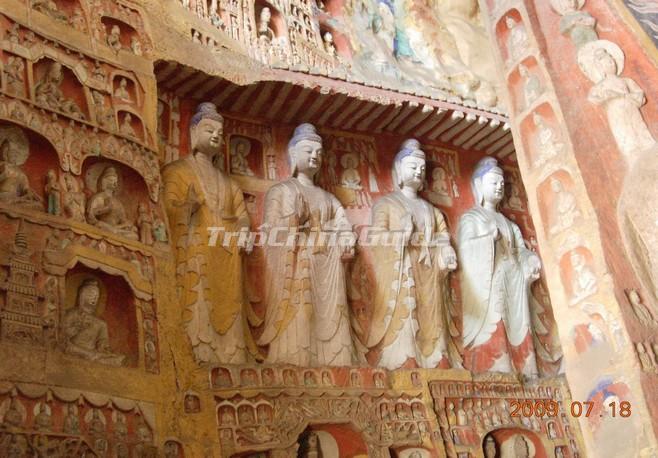Yungang Grottoes Facts
The Yungang Grottoes also known as Yungang Caves, it was called Wuzhoushan Grottoes in ancient time. They are ancient Chinese Buddhist temple grottoes near the city of Datong in the province of Shanxi. They are excellent examples of rock-cut architecture and one of the four most famous ancient Buddhist sculptural sites of China. The others are Longmen Grottoes, Mogao Grottoes and Maijishan Grottoes. The Yungang Grottoes was published as world cultural heritage by UNESCO in 2001.
Location
The site of Yungang Grottoes is located about 16 km south-west of the city of Datong, in the valley of the Shi Li River at the base of the Wuzhou Shan Mountains.
Time of Building
The grottoes were carved between the 5th and 6th centuries.
Numbers
All together the site is composed of 252 grottoes with more than 51,000 Buddha statues and statuettes.
History of the Yungang Grottoes
After the decline of the Jin Dynasty, the northern parts of China came under the control of the Northern Wei. They made the city of Pingcheng, now known as Datong, their capital. Due to its promotion, Pingcheng saw an increase in construction work. The Northern Wei early adopted Buddhism as their state religion. Buddhism arrived in this location via travel on the ancient North Silk Road, the northernmost route of about 2600 kilometers in length, which connected the ancient Chinese capital of Xi'an to the west over the Wushao Ling Pass to Wuwei and emerging in Kashgar before linking to ancient Parthia.
The work on this first period of carving lasted until the year 465 AD, and the caves are now known as caves 16–20. Beginning around the year 471 AD, in a second construction phase that lasted until 494 AD, the twin caves 5/6, 7/8, and 9/10 as well as the caves 11, 12, and probably 13 were constructed under the supervision and support of the imperial court. The imperial patronage ended 494 AD with the move of the Wei court to the new capital of Luoyang. All other caves emerged under private patronage in a third construction period, lasting until 525, when the construction came to a final halt due to uprisings in the area.
Since the end of the works, the sandstone of the grottoes has been exposed to heavy weathering. The ensuing centuries therefore saw several attempts to preserve the caves and to repair sustained damage. During the Liao Dynasty the caves saw some renewing of statues and the buildup of the "10 temples of Yungang" from 1049 to 1060, which were meant to protect the main caves. However, they were destroyed again just some 60 years later in a fire. The wooden buildings extant in front of caves 5 and 6 were constructed in 1621, during the early Qing Dynasty. Since the 1950s, cracks in the sandstone have been sealed by grouting, and forestation has been implemented in an effort to reduce the weathering due to sandstorms.
How to Get
1. Take bus No. 4 at Datong Railway Station and get off at Xin Kai Li. Then transfer to bus No. 3-1 to Yungang Grottoes.
2. There are other bus routes but it is advisable to take taxi or hire a van from downtown Datong to the Grottoes directly. The cost should be about CNY50.
Entrance Fee
CNY 150
Opening Hours
08:30 - 17:20 (April 15 - October 27)
08:30 - 17:00 (October 28 - April 14)
09:30 - 16:30 (the exhibition hall)
Tips for Visiting the Yungang Grottoes
1. Please respect and protect the world cultural heritage and historic sites. Don’t sign your name on caves and buildings in the scenic area. No flash and tri-pot are allowed when taking pictures in the grottoes. Please pay attention to the warning signs and listen to advices from the working staff.
2. No dangerous items and pets are allowed to carry when visiting the Yungang Grottoes. Please behave yourself during the sightseeing since a harmonious environment needs to be maintained by all of us. Please don't litter, smoke and spit.
3. Please queue up in order and don't panic and follow the diverting efforts from the working staff in case of the crowded traffic so as to protect the World Heritage Property.
4. Please pay attention to reminds from the broadcasting station and working staff and evacuate the sight (finish the visit) as soon as possible when the sight is to be closed.
















